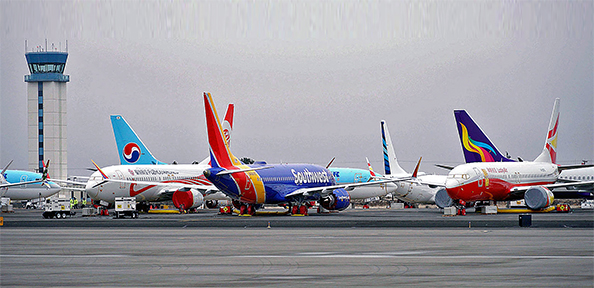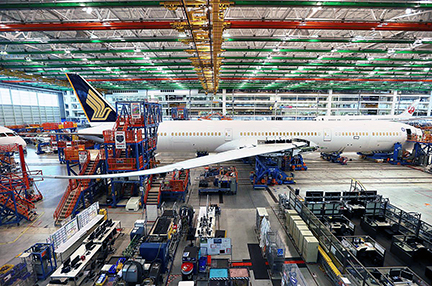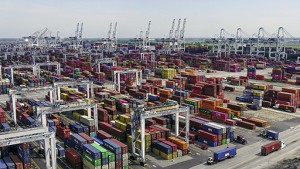
Sure, we created 1.4 million jobs in August and the unemployment rate fell to 8.4 percent. Yet, the U.S. still has 30 million people receiving unemployment benefits after job losses peaked at 50 million in April. But unless businesses — specifically small businesses — get another round of federal help soon, tens of thousands of those business won’t make it for another 90 days.
The Pandemic Emergency Unemployment Compensation (PEUC) program is one that gives additional unemployment benefits from the state after 26 weeks of unemployment. PEUC is a Cares Act program. The PEUC program has economists worried because claims have grown so fast. There are now 1.4 million people signed up for the PEUC as of August, when in March there were 27,000. The number of PEUC recipients — long-term unemployed — has been over 1 million for five weeks, and that number is growing each week.
“The real tsunami is coming,” said Mark Zandi, chief economist at Moody’s Analytics, in an article published by Axios. “My guess is at this point hiring in the industries that have been hit hard is going to abate. That leaves us with very little job creation in the rest of the economy but with still high levels of layoffs. I think the labor market is set to start weakening again here, particularly if Congress and the administration don’t get it together and pass more support,” Zandi said in August.
In September, political officials in Washington said that most likely they are not going to pass another stimulus package before the November election. However, some said that a package will be passed at some point to aid households, small businesses and state and local governments.
Sure, we created 1.4 million jobs in August and the unemployment rate fell to 8.4 percent. Yet, the U.S. still has 30 million people receiving unemployment benefits after job losses peaked at 50 million in April. But unless businesses — specifically small businesses — get another round of federal help soon, tens of thousands of those business won’t make it for another 90 days.
The Pandemic Emergency Unemployment Compensation (PEUC) program is one that gives additional unemployment benefits from the state after 26 weeks of unemployment. PEUC is a Cares Act program. The PEUC program has economists worried because claims have grown so fast. There are now 1.4 million people signed up for the PEUC as of August, when in March there were 27,000. The number of PEUC recipients — long-term unemployed — has been over 1 million for five weeks, and that number is growing each week.
“The real tsunami is coming,” said Mark Zandi, chief economist at Moody’s Analytics, in an article published by Axios. “My guess is at this point hiring in the industries that have been hit hard is going to abate. That leaves us with very little job creation in the rest of the economy but with still high levels of layoffs. I think the labor market is set to start weakening again here, particularly if Congress and the administration don’t get it together and pass more support,” Zandi said in August.
In September, political officials in Washington said that most likely they are not going to pass another stimulus package before the November election. However, some said that a package will be passed at some point to aid households, small businesses and state and local governments.
Economist’s survey shows mixed bag
A survey of U.S. economists by the National Association for Business Economics shows that the U.S. is still in recession as of September. Eight in 10 of the economists surveyed said there is a 25 percent chance of a double-dip recession. The survey also showed that 40 percent believe U.S. lawmakers have not done enough in fiscal response, 37 percent said the response was sufficient, and 11 percent said the response was excessive. A majority of the economists said another round of stimulus (at a value between $1.5 trillion and $2 trillion) must be agreed upon by lawmakers.
 Aerospace industry is a mess
Aerospace industry is a mess
All airlines have announced tens of thousands of job cuts since March, with Texas-based American Airlines cutting 40,000 jobs October 1. But the aero suppliers are also cratering as few jetliners are being sold. U.S. aerospace suppliers have shed more than 120,000 jobs since January. Almost every — no, make that every — aerospace supplier has cut jobs. Spirit AeroSystems, which has a large plant in Eastern North Carolina, has cut 40 percent of its commercial aerospace workforce, or 8,000 jobs. General Electric has cut 13,000 jobs from its aviation unit and Rolls-Royce is closing its plant in Virginia. Dallas-based Southwest CEO Gary Kelley said in an interview with the Dallas Morning News, “Our headquarters can accommodate about 5,000 people roughly, and there are maybe 100 people here every day.”
Manufacturing improving
The Institute for Supply Management (ISM) reported in September that its purchasing manager’s index grew to 56 in August from 54.2 in July. Those are the highest scores since the end of 2018. Any ISM reading above 50 percent represents an expansion of the manufacturing sector in the U.S.
COVID reveals weakness in U.S. manufacturing
The coronavirus is almost eight months old and the U.S. is still suffering from delays and shortages in test kit components, PPE and pharmaceuticals. With a reliance on foreign producers of these elements and materials, U.S. companies just cannot purchase enough of these items. Thirty years of globalization and decades of offshoring U.S. companies has put America in this position.
Manufacturing is hiring again, but we have a long way to go
In the first six months of 2020, the coronavirus devastated the American economy. On the manufacturing side, the first six months of 2020 saw the U.S. lose about 750,000 manufacturing jobs. In the summer, the U.S. again started to create manufacturing jobs; however, less than 100,000 jobs were generated by the sector in June, July and August. The coronavirus wasn’t the only factor that killed so many manufacturing jobs. The roller coaster Trump trade laws, including the tariffs that were implemented, also cost manufacturing jobs in the U.S. In fact, nearly 1,800 manufacturing plants closed in the U.S. from 2016 to 2018. The 750,000 lost manufacturing jobs in the first half of 2020 wiped out all manufacturing job gains from the decade of 2010 to 2020.
Five years of GDP wiped out in one quarter
Gross domestic product fell by 9.5 percent in the second quarter of 2020, wiping out five years of growth. The collapse — the equivalent of a 32.9 percent annual rate of decline — is the largest single quarter drop in U.S. history.
 Boeing cuts production, consolidates 787 assembly to South Carolina
Boeing cuts production, consolidates 787 assembly to South Carolina
In the spring and summer, demand for airliners collapsed as a result of the coronavirus. Boeing currently fully assembles its 787 jetliner in Everett, Wash. and North Charleston, S.C. The company announced in September it is consolidating 787 Dreamliner wide-body jet assembly to North Charleston as the aerospace giant struggles.
The Mississippi Delta is suffering
The economy as a result of the pandemic has been damaged all across America. The Mississippi Delta, one of the most impoverished regions of the country, has been hit especially hard. Four of the highest unemployment counties in the Arkansas Delta as of August are Chicot County (13 percent); Mississippi County (12.6 percent); Phillips County (11.8); and Crittenden County (11.6 percent). Other findings from a Feeding America survey show that the Delta regions in Alabama, Arkansas, Louisiana and Mississippi have the four highest rates of food insecurity in the nation. A University of Louisiana at Lafayette report showed that job losses from the pandemic are twice as high as those from Hurricane Katrina.
Job growth to slow dramatically over the next decade
The Labor Department predicted this summer that job growth will drop by more than two thirds from 2020 to 2029. The economy is expected to add a net 6 million new jobs over the next decade for a 0.4 percent compared to 1.3 percent annual rate from 2009 to 2019. That’s an average of 50,000 jobs a month. From 2009 to 2019, there were several months when the U.S. saw over 300,000 jobs a month. The biggest reason why jobs will slow (and we have been writing about this for years) centers on an aging Baby Boomer workforce.
Large cities in the South growing faster than in other U.S. regions
The South leads all other U.S. regions in population growth, according to recent Census Bureau data. Ten of the top 15 fastest growing cities in the U.S. are in the South, including Atlanta, Charlotte, Houston, San Antonio, Dallas, Austin and others. In fact, last year, according to Census data, Charlotte passed San Francisco to become the nation’s 15th largest city. Populations in large Southern cities grew by an average of 11.8 percent between 2010 and 2019. Large cities in the West grew by 9.1 percent during those nine years, followed by the Northeast (3.1 percent) and the Midwest (1.5 percent).
U.S. exports have cratered in 2020
Exports in the first and second quarters are down significantly as a result of the virus. Based on data from the Missouri Economic Research and Information Center, total value of exports fell by 26.3 percent in Q1. In Q1 2019, total value of exports was $395 billion. In Q1 2020, exports dropped to $291 billion. In Q2 2019, exports were valued at $415 billion and that figure dropped to $291 billion in Q2 2020.
Charleston Harbor project on schedule and funded
The Charleston Harbor deepening project is on schedule and on time to achieve a depth of 52 feet by 2022. Once completed, Charleston, S.C., will have the deepest harbor on the East Coast. The cost of the project is $558 million.
South Carolina ports see some positive signs
The South Carolina Ports Authority handled 208,837 20-foot equivalent containers (TEUs) at its terminals in Charleston in August. That is down about 10 percent from August 2019. However, compared to other months in the summer, it’s a positive sign. TEUs are up 18 percent since July and 33 percent since June.
Dallas leads nation in large commercial property deals in first half of 2020
Real Capital Analytics reported in the summer that Dallas beat out New York, Los Angeles and Chicago in large commercial real estate deals in the first half of 2020. It’s the first time ever that Dallas led all other markets mid-year. Sales activity in Chicago, Los Angeles and New York was down on average 40 percent. Dallas had more than $9 billion in property transactions the first half of this year.
Will the coronavirus threaten shale boom?
The shale and oil industries in the South are massive employers. The pandemic has slowed the demand for crude and natural gas dramatically. As a result, drillers have shut down wells en masse throughout the South. Last year, the U.S. was the world’s top oil producer, producing 13 million barrels a day. It might be years (if ever) before the U.S. again produces 13 million barrels a day according to oil and natural gas executives. According to research by Rystad Energy, oil and gas companies are expected to lose $1 trillion in revenues this year.
 Dallas leads all U.S. markets in employees returning to the office
Dallas leads all U.S. markets in employees returning to the office
Tens of millions are still working from home, but those in Dallas are leading the country in returning to their offices amid the COVID-19 pandemic. With 36 percent of employees going back to the office, Dallas leads the nation. The nationwide average as of September was 23 percent, according to a report by Kastle Systems.
 Port of Savannah No. 1 in exports
Port of Savannah No. 1 in exports
The Port of Savannah exported more loaded containers than any port in the country between January and May of this year. The port rang up a 12.2 market share among other ports in the country in container exports, according to the Georgia Ports Authority.
U.S. might get to 90 percent renewable energy in 15 years
Experts on climate have maintained in the last few years that it wouldn’t be possible to run the electric grid on 100 percent renewable energy until 2050. However, those same experts have now stated that because the cost of renewable energy from solar, wind and battery storage has fallen so quickly, the nation could be run on 90 percent carbon-free energy by 2035.
U.S. oil, gas and coal industries have lost 118,000 jobs so far this year
As a result of the coronavirus, the U.S. fossil fuels industry lost 118,000 jobs between March and July. That’s a 15.5 percent drop in employment for the sector, according to a report by BW Research Partnership. Several companies have sought bankruptcy as the virus has cut demand for oil and gas.
In a landmark period in this nation’s history, renewable power is poised to top coal power this year
The U.S. is nearing the point when renewable energy will surpass that of coal generation for the first time in over 120 years. Ten years ago, coal-generated electricity provided nearly 50 percent of the nation’s power to homes and businesses.
Jobs lost in Louisiana the first half of 2020 almost double Katrina
In the first half of 2020, jobs in Louisiana fell by 11 percent as a result of the coronavirus. That is almost twice the number of jobs lost in Katrina, which was a 6 percent drop. Over 218,000 jobs were lost in Louisiana in the first and second quarters of 2020.
Multi-billion dollar energy projects in Louisiana to slow
According to the LSU Center for Energy Studies, the amazing 10-year run of energy and petrochemical projects in Louisiana will slow until at least 2025. In recent years, multi-billion-dollar energy projects, such as Cheniere’s LNG export facility in Southwest Louisiana, will slow until there is greater demand for crude oil and natural gas, or until there is a cure or treatment for the coronavirus.
Dallas-Fort Worth’s office market struggles
Dallas-Fort Worth’s office market saw a negative 1.8 million square feet net leasing in the second quarter. It is the lowest net leasing total since the Great Recession.
Clawbacks for Deutsche Bank in North Carolina
Incentives for Deutsche Bank have been revoked because the German bank cannot meet the job levels it agreed upon. The company has its software center in Cary, N.C. The bank agreed to hire 250 workers in 2015 in exchange for $3.4 million in incentives. Deutsche Bank is reducing its worldwide workforce by 18,000.
Austin suburb named the fastest growing city in the U.S.
Leander, located just 30 minutes northwest of downtown Austin, has earned the fastest growing city title for 2018 and 2019. In 2010, Leander had just over 27,000 residents. This June, the number of residents totaled 73,000. Sales tax receipts in Leander are up by 23.8 percent in the last year.
Only one metro added jobs in June, and it’s in Kentucky
In June, only one metropolitan area in the country decreased its year-over-year unemployment from June 2019 to June 2020. That metro area is Owensboro, Ky. Its unemployment rate, according to the Bureau of Labor Statistics in June 2019, was 4.4 percent. In June 2020, it dipped to 4.2 percent.
Alabama establishes innovation commission
Gov. Kay Ivey has formulated Alabama’s first statewide commission on entrepreneurship and innovation. The Alabama Innovation Commission, also known as Innovate Alabama, will help innovators in the state collaborate with other innovators and policymakers.
Global air travel down to next to nothing
In August, global air travel was down 85 percent compared to the same month last year. The International Air Transport Association said that carriers will lose $84 billion this year, the worst year ever for the industry. Air traffic at Europe’s 500 airports is down 94 percent compared to last year.
 Living in Austin is expensive
Living in Austin is expensive
Move.org ranked Austin, Texas, as the least affordable city in the U.S. for minimum-wage workers. Following Austin as the least-livable cities in the U.S. for low-wage workers were Plano, Texas; Virginia Beach; San Francisco and Jersey City, N.J.